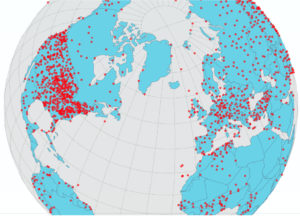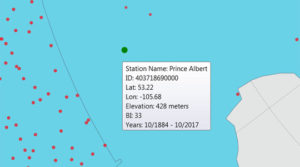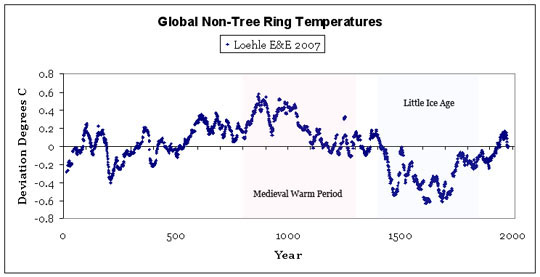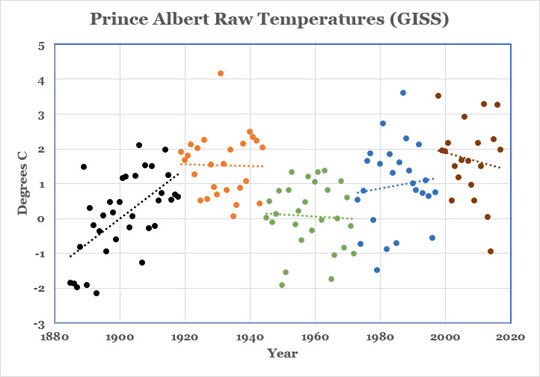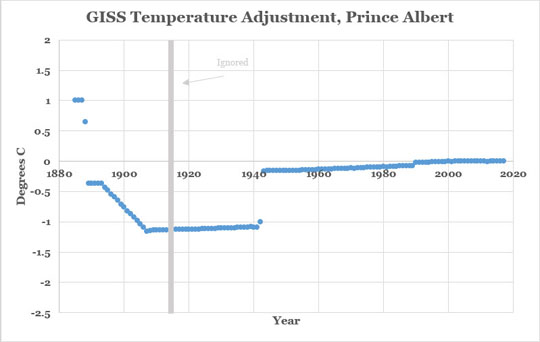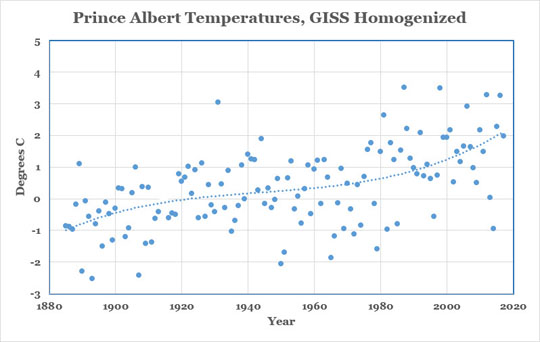As noted in a previous post, one aspect of the science of global warming is the measurement of ground temperature on a local basis. This kind of measurement is located on a really sporadic basis throughout the world, but the most coverage is in the United States as shown in the global view of station data from NASA on Goddard Institute for Space Studies (GISS). The extrapolation of all these sites to create a global temperature is obviously difficult, yet that is exactly what happens in climate science all the time. So, to look further afield, let’s analyze a more northern site where warming should have a larger effect, Prince Albert station in Saskatchewan, Canada.
Prince Albert station is about 90 miles north of Saskatoon in an area just at the end of aspens into boreal forest, a transition zone along a river. The station is considerably north of most US sites. Compared to the Connecticut site previously studied, this is cold, over 7 degrees C colder (13 degrees F).
Moreover, the Prince Albert station has the distinct advantage of having operated longer than the station in Connecticut, from about 1885. Because of that, the raw temperature data shows the climb out of the Little Ice Age. The Little Ice Age involved a significant decrease in global temperature from about 1300 AD to 1850 AD with ramps on either side. The temperature reconstruction of Loehle1 is shown. (As usual, Wikipedia cannot be trusted on this subject due completely dishonest editing.)
The raw station temperatures from Prince Albert exhibit distinct phases, albeit with a great deal of variability. The first phase, from 1885 until about 1918 shows the climb of temperatures out of the Little Ice Age. This period is missing from the Connecticut data set which starts in 1916.
The second phase shows the warmer temperatures in the early part of the 20th century, from 1919 until about 1944. 1931 was a black swan year in that part of Canada with anomalously higher temperatures. To the south, it marked the start of a drought period in the Great Plains which extend up into Canada just south of Prince Albert.
But then, after the mid-1940s, the temperatures drop. The third phase shows a distinct period of lower temperatures from 1945 until about 1973. This is followed by a slow increase of temperature until 1998. Again, the variation (standard deviation) of temperature is much larger here than for the Connecticut station, being about +-0.94 degrees C rather than +-0.6 degrees C.
Lastly, the current phase shows a drop in temperature from 1999 until the present. Please note that the Prince Albert station was apparently moved in 1963. The plot from 1885 until 2017 is shown.
Sometime in the last few years, just before the Paris Conference on Climate Change, GISS decided to modify the temperature data to account for perceived faults in its representation of atmospheric temperature. Or, more accurately, the Global Historical Climatology Network (GHCN) from NOAA decided to “homogenize” the raw temperature data. And the changes are shown and used by GISS. Those changes for the Prince Albert station are shown.
The early temperatures around 1900 are ramped down. The remaining temperatures up until 1943 are decreased by about 1.1 degrees C. The temperatures from then on to the present see small but consistently decreasing changes.
While the reasons for change are many, the main reason given appears to be urban sprawl into the measurement sites. They said, “GISS does make an adjustment to deal with potential artifacts associated with urban heat islands, whereby the long-term regional trend derived from rural stations is used instead of the trends from urban centers in the analysis.”
The net result of these changes on the temperatures at Prince Albert are shown. Note that the climb out of the Little Ice Age is washed out by artificially lowering the peak of temperatures in the early 1900s. And, because of the greater variability in the measured temperatures, the pause in temperature increases observed since 1998 is harder to discern. Curiously, this fits the current climate change narrative better than the raw data.
[1] Loehle, Craig, Energy & Environment, 18 No. 7+8, 2007

